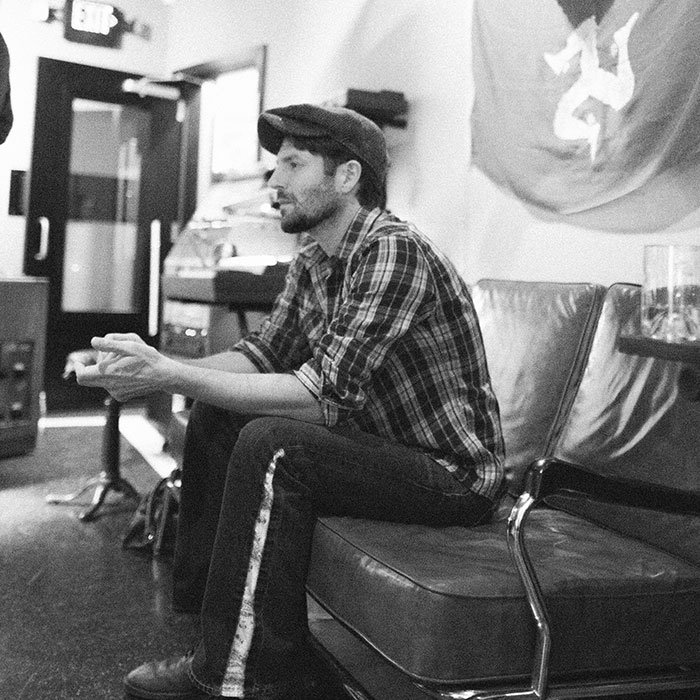Ray LaMontagne’s alarm clock delivered a life-changing epiphany when it blared Stephen Stills’ “Treetop Flyer” at four in the morning to get him up for his dead-end job at a Lewiston, Maine shoe factory.  Most people loathe their alarm clock.
Most people loathe their alarm clock.
Videos by American Songwriter
Some smack at it in a bleary-eyed stupor in hope of snoozing for a scant nine minutes. Others simply rip the chord from the wall. Ray LaMontagne’s alarm clock delivered a life-changing epiphany when it blared Stephen Stills’ “Treetop Flyer” at four in the morning to get him up for his dead-end job at a Lewiston, Maine shoe factory.
“It’s like a light went off and everything became very clear to me,” LaMontagne recalls in a measured tone, nearly 12 years later. “That period of my life was a dark, dark time, but I knew at that moment exactly what I wanted to do; I wanted to play music.” Skipping work, LaMontagne bought Stills Alone and a short time later sold his VW van to buy a Martin guitar. As he learned to play, he immersed himself in the canon of classic American music.
“Neil Young, Crosby, Stills and Nash, tons of Bob Dylan, Joni Mitchell, Ray Charles, Otis Redding, Aretha Franklin, The Grateful Dead, The Band, all the mainstays I guess,” LaMontagne remembers. “From the time I was 20 until I was about 26; that’s when I really listened to music. When I wasn’t working, I was listening to records over and over again. I learned how to play the guitar and was just amazed by singers and how a certain turn of a phrase or a syllable can just kill you. I just loved it, loved it, loved it. Then, I bought a piece of land and started working on my cabin. I was cut off from listening to music for years. We didn’t have electricity out there, so that’s really when I started to write my own songs.”
The songs LaMontagne wrote late at night in his cabin in the woods-inspired by his musical heroes and the dark, intimate ambiance of his surroundings-were nothing short of heroic. His soulful vocals fit perfectly with the plaintive songwriting and sparse acoustic guitar-driven melodies. Wrought with despair and anguish, songs like “Burn” and “Jolene” were emotional firestorms teetering on the brink of collapse, while “Shelter” and “Trouble” were exultations of joy. These were classics in the making, heard only by the shadows in LaMontagne’s cabin for years as he mounted the courage to share his music with the outside world.
In the summer of 1999, LaMontagne recorded a 10-song demo, which he shared with a local theater owner, hoping to get some gigs opening for touring folk acts. But it was a gig a few years later at a fan’s company picnic in nearby Portland that led to a phone call from Jamie Cerreta at Chrysalis Music, a leading independent music publisher. As fate would have it, Ethan Johns, son of legendary producer Glyn Johns and an experienced and accomplished producer and musician in his own right, was among the first Cerreta asked to listen to the young songwriter’s music. Johns was overwhelmed with what he heard and offered to produce a cleaner demo that Chrysalis could then shop to major labels.
“We had a very, very, very small amount of money, really enough for studio time and tape,” LaMontagne says. “Once we got started, over lunch one day Ethan just said, ‘Let’s just make a record, man. Forget about making demos. Let’s just make a record.’ He was very generous in that he didn’t take any money to do the record with me. We took two weeks and really quickly went through the material I had and did the best we could. It was a great experience and I definitely wouldn’t trade it for the world. And a big part of that experience was doing it with Ethan. I was pretty much a wreck during that time. I was not very aware of music. At that time, I was living in the cabin and had been for five years. I was completely cut off from what was going on in contemporary music altogether. I listened to records that were 30 years old, and that’s when I could even listen to them. I was a carpenter at that time and I just had a bunch of songs. Ethan knew how to work a tape machine and could play drums really well. That’s really it. He was exactly what I needed and came along at the right time for me in my life.”
The result of LaMontagne’s early morning epiphany and b’shert collaboration with Johns was Trouble, his 10-song debut released in 2004 on RCA Records, which won a multi-label bidding war to sign him. The album has sold nearly half a million copies to date, garnered widespread critical acclaim and drawn comparisons to everything from Joe Cocker and Otis Redding to Van Morrison’s seminal masterpiece, Astral Weeks. Admiration from his musical peers soon followed; Sir Elton John was reported to be a fan, and Kelly Clarkson covered the third single off the album (“Shelter”) on the ReAct Now: Music & Relief benefit concert following Hurricane Katrina. Sheryl Crow name dropped him continually in a recent MOJO interview and listed Trouble as one of her “Top 25 Road Trip Albums.” Allman Brothers guitarist and Gov’t Mule frontman Warren Haynes heard an advance copy of the record in September 2004 and was astounded.













Leave a Reply
Only members can comment. Become a member. Already a member? Log in.